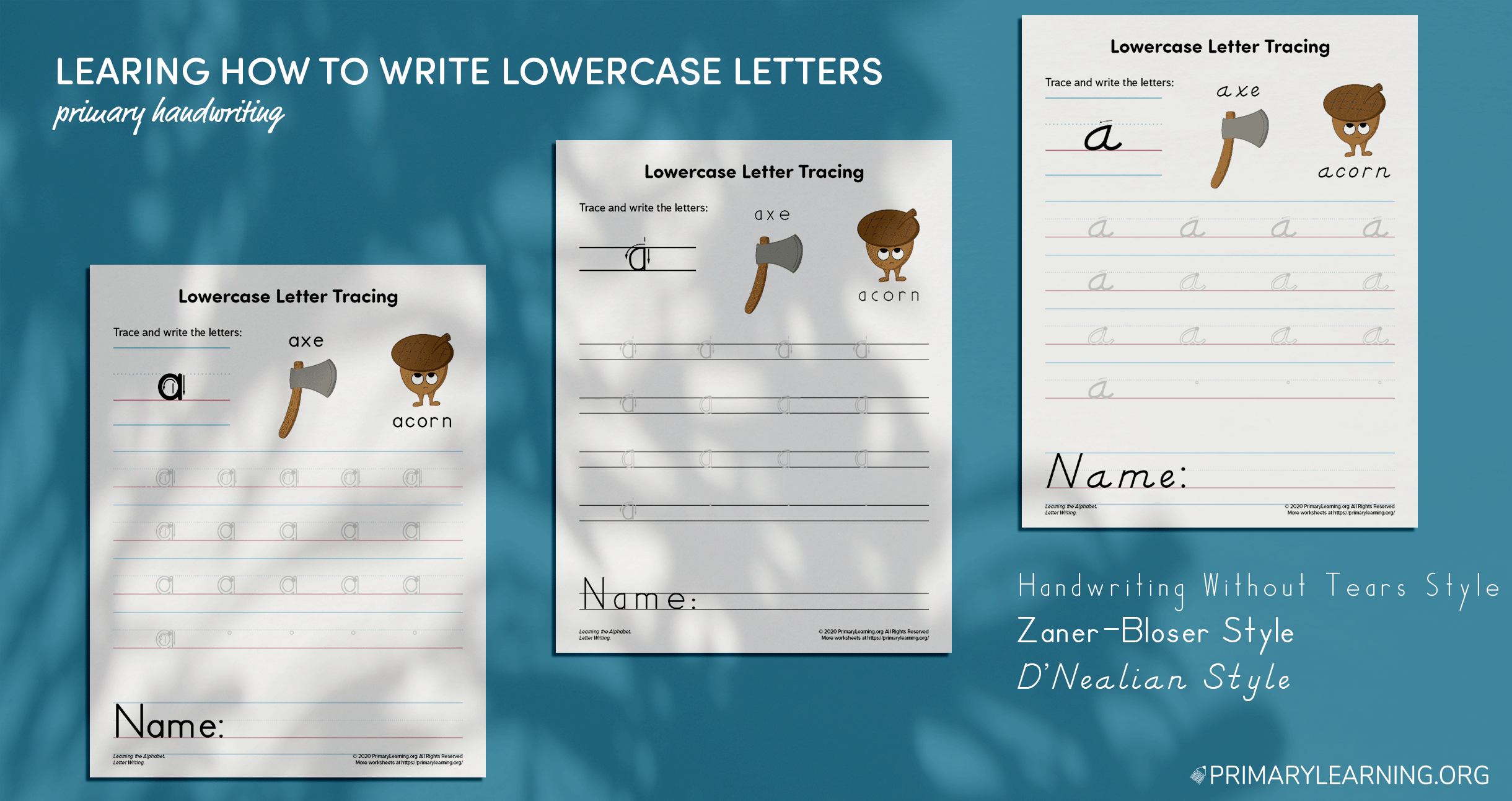

Posted by: Alesia Netuk
Updated: October 2nd, 2023
Learning How to Write Lowercase Letters
Learning How to Write Lowercase Letters
Although some may argue that children should learn to print lowercase letters first, they are actually more complex than uppercase letters. First, while uppercase letters all begin at the top, lowercase letters have many different starting points. Consider where to place your pencil to start making the letters b, a, f, and e. Each one has a different starting point. Also, while uppercase letters start at the top and then travel downward, lowercase letters travel in various directions. Compare printing the letter e and the letter m. There are few similarities between their pathways.
What Order is Best to Teach Letters
When introducing the lowercase letters, give consideration to ones that share similar pathways. Letters that use only vertical and horizontal lines and do not have curves can be easier to begin with. These are the letters l, t, and i. Next, introduce the many letters whose pathway is similar to their uppercase counterpart. Children will already be familiar with the pathway for letters like c, o, s, and x. The main teaching point is to start each letter at the midline instead of the top.
Recommended Handwriting Without Tears style letter order.
Recommended Zaner-Bloser style letter order.
The remaining letters to introduce are those that have both a straight line and a curve, like a, h, n, and r, and letters with diagonal lines, like k and y. As you are introducing letters, it is important to be responsive to each child’s learning needs. Are there certain letters that are more difficult? Is more practice needed for a letter before moving on to another? Do you need to pause and review all the letters learned thus far before introducing another? There is no set timeline for when children are learning how to print. Remain flexible and adapt to their needs.
Example of multisensory explicit instructions when teaching writing lowercase letters
Today you’re going to learn the letter B and the sound it makes. Say the letter. (b) Book, bird, bat, bed, baby, ball, barn start with a sound /b/. Say these words with me. (book, bird, bat, bed, baby, ball, barn).
SOUND OUT & WRITE IT
First, let’s write the letter B in the air with your index finger (or using a juggling scarf). Start at the top, pull down, push up straight and circle forward all the way around! (model the letter together with a child and say it aloud b)
Let’s look at these words and trace the letters. Look at the top of the page. What do you see? (bee, bird) Let’s say the beginning sound. /b/ What letter spells the sound /b/? (b) Trace a b. Begin your writing with a starting dot and follow directions to form a letter. Start at the blue headline. Pull down straight to the red baseline. Push up straight and circle forward all the way around. (you can use the handwriting worksheets below to teach all letters)
Tracing Lowercase Letter A
Kids practice their handwriting by tracing lowercase letter A by following directions and develop proper letter A formation from the beginning. For preschool and kindergarten.
Tracing Lowercase Letter A
Tracing Lowercase Letter B
Kids practice their handwriting by tracing lowercase letter B by following directions and develop proper letter B formation from the beginning. For preschool and kindergarten.
Tracing Lowercase Letter B
Tracing Lowercase Letter C
Kids practice their handwriting by tracing lowercase letter C by following directions and develop proper letter C formation from the beginning. For preschool and kindergarten.
Tracing Lowercase Letter C
Tracing Lowercase Letter D
Kids practice their handwriting by tracing lowercase letter D by following directions and develop proper letter D formation from the beginning. For preschool and kindergarten.
Tracing Lowercase Letter D
Tracing Lowercase Letter E
Kids practice their handwriting by tracing lowercase letter E by following directions and develop proper letter E formation from the beginning. For preschool and kindergarten.
Tracing Lowercase Letter E
Tracing Lowercase Letter F
Kids practice their handwriting by tracing lowercase letter F by following directions and develop proper letter F formation from the beginning. For preschool and kindergarten.
Tracing Lowercase Letter F
Tracing Lowercase Letter G
Kids practice their handwriting by tracing lowercase letter G by following directions and develop proper letter G formation from the beginning. For preschool and kindergarten.
Tracing Lowercase Letter G
Tracing Lowercase Letter H
Kids practice their handwriting by tracing lowercase letter H by following directions and develop proper letter H formation from the beginning. For preschool and kindergarten.
Tracing Lowercase Letter H
Tracing Lowercase Letter I
Kids practice their handwriting by tracing lowercase letter I by following directions and develop proper letter I formation from the beginning. For preschool and kindergarten.
Tracing Lowercase Letter I
Tracing Lowercase Letter J
Kids practice their handwriting by tracing lowercase letter J by following directions and develop proper letter J formation from the beginning. For preschool and kindergarten.
Tracing Lowercase Letter J
Tracing Lowercase Letter K
Kids practice their handwriting by tracing lowercase letter K by following directions and develop proper letter K formation from the beginning. For preschool and kindergarten.
Tracing Lowercase Letter K
Tracing Lowercase Letter L
Kids practice their handwriting by tracing lowercase letter L by following directions and develop proper letter L formation from the beginning. For preschool and kindergarten.
Tracing Lowercase Letter L
Tracing Lowercase Letter M
Kids practice their handwriting by tracing lowercase letter M by following directions and develop proper letter M formation from the beginning. For preschool and kindergarten.
Tracing Lowercase Letter M
Tracing Lowercase Letter N
Kids practice their handwriting by tracing lowercase letter N by following directions and develop proper letter N formation from the beginning. For preschool and kindergarten.
Tracing Lowercase Letter N
Tracing Lowercase Letter O
Kids practice their handwriting by tracing lowercase letter O by following directions and develop proper letter O formation from the beginning. For preschool and kindergarten.
Tracing Lowercase Letter O
Tracing Lowercase Letter P
Kids practice their handwriting by tracing lowercase letter P by following directions and develop proper letter P formation from the beginning. For preschool and kindergarten.
Tracing Lowercase Letter P
Tracing Lowercase Letter Q
Kids practice their handwriting by tracing lowercase letter Q by following directions and develop proper letter Q formation from the beginning. For preschool and kindergarten.
Tracing Lowercase Letter Q
Tracing Lowercase Letter R
Kids practice their handwriting by tracing lowercase letter R by following directions and develop proper letter R formation from the beginning. For preschool and kindergarten.
Tracing Lowercase Letter R
Tracing Lowercase Letter S
Kids practice their handwriting by tracing lowercase letter S by following directions and develop proper letter S formation from the beginning. For preschool and kindergarten.
Tracing Lowercase Letter S
Tracing Lowercase Letter T
Kids practice their handwriting by tracing lowercase letter T by following directions and develop proper letter T formation from the beginning. For preschool and kindergarten.
Tracing Lowercase Letter T
Tracing Lowercase Letter U
Kids practice their handwriting by tracing lowercase letter U by following directions and develop proper letter U formation from the beginning. For preschool and kindergarten.
Tracing Lowercase Letter U
Tracing Lowercase Letter V
Kids practice their handwriting by tracing lowercase letter V by following directions and develop proper letter V formation from the beginning. For preschool and kindergarten.
Tracing Lowercase Letter V
Tracing Lowercase Letter W
Kids practice their handwriting by tracing lowercase letter W by following directions and develop proper letter W formation from the beginning. For preschool and kindergarten.
Tracing Lowercase Letter W
Tracing Lowercase Letter X
Kids practice their handwriting by tracing lowercase letter X by following directions and develop proper letter X formation from the beginning. For preschool and kindergarten.
Tracing Lowercase Letter X
Tracing Lowercase Letter Y
Kids practice their handwriting by tracing lowercase letter Y by following directions and develop proper letter Y formation from the beginning. For preschool and kindergarten.
Tracing Lowercase Letter Y
Tracing Lowercase Letter Z
Kids practice their handwriting by tracing lowercase letter Z by following directions and develop proper letter Z formation from the beginning. For preschool and kindergarten.
Tracing Lowercase Letter Z
LEARNING MATERIALS TO MEET EVERY CHILD’S NEEDS
Here, at PrimaryLearning.Org, we tend to deliver the best-differentiated learning materials to K-2 students. Our resources can be easily incorporated into multisensory lessons to meet every child’s needs, whether s/he is a visual, kinesthetic, or auditory learner.